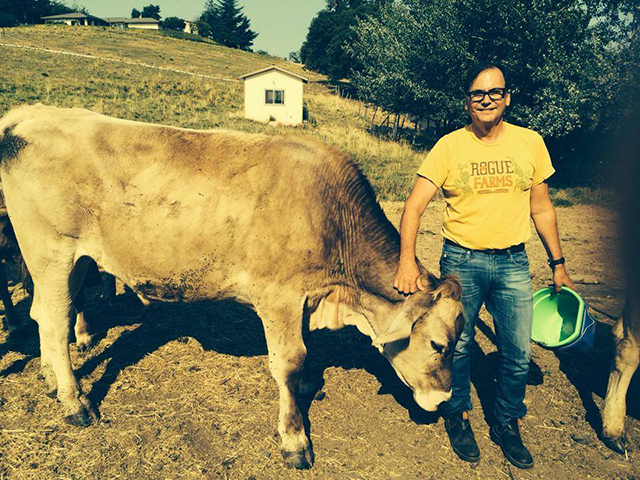Meet The Maker: David Gremmels Of Rogue Creamery
By Erika Kubick in Food on Apr 17, 2015 2:45PM

David Gremmels. Photo courtesy of Facebook.
Raw Milk Cheese Appreciation Day is this Saturday, and we can't wait to celebrate with raw cheese of all shapes and sizes. After interviewing both Prairie Fruits Farms and Jacobs & Brichford, we're heading to the Pacific Northwest to chat with the premiere blue cheese maker in the nation, Rogue Creamery, in Oregon. The historic farmstead creamery has made cheese since the '30s. Today, we're speaking with cheese maker David Gremmels, who owns the creamery with his partner, Cary Bryant. The two purchased the creamery in 2002 and have since continued Rogue's legacy with award-winning cheeses, such as their Rogue River Blue.
We use open vats so that flavor is further developed in the environment in which we make the cheese. Rogue Creamery has made cheese in the same environment since 1933, long before we purchased it in 2002. Our cheeses are aged in our man-made caves, which have also been operating since the '30s. The flavors of the resulting cheese don’t only depend on what we add to the vat, but also the cultures, molds and fungi that are in the aging environment. Everything combines to create a complex flavor experience that complement and enhance the flavors in the raw milk.
C: Can you describe the flavors of your raw milk cheese?
David Gremmels: The signature notes in blue cheese include umami, saltiness and, of course, piquant blue. In our cheese, you get underlying notes of grass, cereal, fruit and a hint of sharp huckleberry, which comes through ever so slightly. There’s also this savory note that comes at the end of the flavor experience - some say it’s a little bit like bacon. All of the flavors melt and dissolve into a creamy sweetness that finishes the experience.
C: Why do you make pasteurized cheeses?
David Gremmels: We started making pasteurized cheeses in order to crack into the market in Australia. We’ve put a lot of time and energy into developing pasteurized cheeses that are often mistaken for raw cheeses. Over the last 13 years, we have been building an organoleptic database that has identified characteristics of our raw milk cheese in texture, flavor, and aromatics. The flavor is attributed to multiple factors that affect the characteristics of the cheese. We feel that the less you do to milk, the better the resulting cheese. We don’t homogenize our milk and it’s very gently handled, even when it’s pasteurized. We add specific cultures to the recipe and with age, the flavor that emulates that of raw milk cheese develops.
C: Is this process possible for smaller creameries to achieve?
David Gremmels: We are a smaller creamery, we have a herd of about 100 cows. It’s just about where you set your priorities.
C: What are some of your favorite raw milk cheese?
David Gremmels: A few days ago I set out to make the best raw milk cheese plate. I built it with three cheeses. I wanted something to start our palate, so I selected an aged raw milk cheddar from Rogue Creamery. Then I selected Pleasant Creek, a raw goat Gruyere-style made from Nigerian Dwarf goat milk at Pholia Farms in Oregon. The finale was our Caveman Blue, which was aged to perfection at four months. I complimented it with a raw honey from the farm. It was magic.
David Gremmels:I’d like to say that raw milk cheeses are equally as healthful and safe as pasteurized cheeses. One health benefit is due to the digestive enzymes that are still intact and part of the whole experience. Raw milk cheese brings a biodiversity into our menus that is necessary to balance today’s eating style. Also, for those who have developed their palate for cheese, they will notice a layered complexity in a raw milk cheese and a flavor that is attributed to the region. I believe there is a healthful aspect to raw milk cheese that we are committed to creating for our cheese lovers. It’s important to continue this craft that is both traditional and innovative for our culture.
If you'd like to learn more about Rogue Creamery, David Gremmels will be sampling cheese and answering questions at Pastoral's Artisan Producer Festival, April 25 at Chicago's French Market. Raw Milk Cheese Appreciation Day is this Saturday, April 18. You can celebrate with cheese makers at Eataly Chicago or head to Potash Market on State Street where raw milk cheeses are 10% off for the day. Raw Milk Cheese Appreciation Day is brought to you by the Cheese of Choice Coalition, an organization dedicated to raw milk cheese awareness.